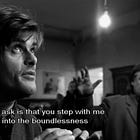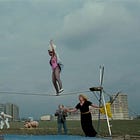◡◶▿ AMAT10 | Home
The 8mm mistake that can tear your world in two. Kira Muratova's secret sect. Plus: new homemade Italian 1976 outer space birth movie just dropped. | Advanced Amateury Week 10
Hello again! In last week’s lesson, on Shabbiness, we learned how:
The affectionate audience cherishes a filmmaker’s clumsiness like the handwriting of a loved one.
Boom-in-frame type events are epic and eloquent ruptures in the cine-textual fabric.
But intentional filmmaking smudges - such as the Hollywood lens flare - patch over filmmaking’s essential blowholes.
A shadow cinema culture exists where everybody admits that a film is just people doing things - and that this is marvellous.
In today’s lesson, we will discuss:
🐿️ The home moviemaking mistake that can shunt your family onto separate planes of existence.
🥯 The “modest sandwich” definition of home moviemaking.
👩👦 Kira Muratova’s hand-me-down break-up movie.
📴 A thought experiment about your neighbour’s Nokia.
Missed a week? Joined late? Don’t worry about reading these lessons out of order. Each functions independently. They are sent in a sensible sequence but hardly reliant on it.
Please share this lesson with everyone in your home(s). Here we go.
Squirrel
You can hear me deliver this lesson by scrolling up to the header and clicking Listen and/or the play ▸ button.
“If, during a walk with the family, a squirrel suddenly darts across the path, and if, as might well happen, you record this on film, consider how the incident could be incorporated in the family film,” suggests J. D. Beal, not unreasonably, in Cine Craft, his book.
But what Beal says next will tear your world in two:
“Surely the thing to do is to aim the camera next at a child and ask him to point suddenly to one side at a given signal.”
Surely!
What just happened? You look to your husband, your daughter, your dog. They look back at you. They know what you did. And they understand.
Your young son is too caught up with park business for the incident to register. He pointed, as directed - and then moved on with his life. But in many ways, he will never quite be part of the same family again. The family who know what you did.
“If this shot is eventually shown just before the shot of the squirrel,” Beal continues, “an elementary principle of editing will have supplied interest and coherence to an otherwise irrelevant - though attractive - shot.”
Okay. But let’s not post-rationalise, Beal. Directing the child and faking his glance changed everything. Editing it into your “family film,” some months later, is just a formality. Months have passed. And everything’s changed.
What isn’t the home movie?
See also: What is(n’t) an amateur?
The home movie is best characterised by its humility or humbleness. Or better said, humblenesses, for one or more of several humblenesses may be at play:
Humbleness of technique.
Humbleness of investment (time, money, identity, commitment).
Humbleness of talent (because even where it exists, it remains downplayed, undeveloped, and/or by-the-by).
Humbleness of completion. (It is fully formed even if it exists as an ongoing continuum [of film reels or tape] or unsorted scrap or scraps [video files]).
Humbleness of distribution (there may be only one copy and it may hibernate, forgotten, for years).
Humbleness of exhibition.
A home movie needn’t be made in the home. It need not pass, at any moment, through your physical home or homes. Is the home movie a state of mind? Maybe. Or maybe a state of heart or a state of belly or a state of fingers.
A home movie needn’t be made in the home. Indeed, the career home moviemaker might soon tire of their home interior and garden as a film set. Too many samey sequels!
The home movie might exist as a satellite instead. A satellite sub-genre. Some satellite sub-genres of the home movie include:
The holiday movie.
The picnic movie. (More broadly, the excursion movie.)
The street movie.
The repair shop movie (characterised by the presence, in close-up, of the proprietor’s thumbs).
The pocket movie.
The parade movie.
The sky movie.
Certain wedding movies.
Certain birth movies.
The prenatal scan movie (most particularly when shot in portrait orientation despite the clear example of the hospital monitor itself).
These sub-genres are defined by their location. Or by an activity associated with a particular location type. A home movie needn’t be made in the home. The home movie is best characterised by its humility or humbleness.
“Humility” and “humbleness” come to us from the Latin humus.1 From the earth, the soil. The “home” is a friendly place to lay, to settle; the “house,” a place of shelter, to hide or store. Three word families related in theme if not etymology. Three good concepts to hold in your heart when tempted to make your home movie something it isn’t. A modest sandwich: the earth, a bed, and a lid on top.
So maybe the home movie can be mighty on a small scale. Vine leaves gripping the ground, the walls, strong, proud, but not presumptuous. The home movie should not venture beyond its conceptual threshold. Its status as a home movie becomes more troubled the further it strays.
Should the home movie venture beyond its threshold, the filmmaker must reconsider their definition of this movie as a home movie, or their definition of home.
A hand-me-down-film
The Long Farewell (Dir: Kira Muratova, 1971) is an extraordinary movie about the dissolution of a home.
It is not a home movie.2 But when the film was suppressed by authorities, it developed a curiously hermetic exhibition life: “[d]uring the sixteen years that The Long Farewell was withheld from release, it was regularly shown to students at VGIK, in Moscow,” reports Jane Taubman, “where it influenced a whole new generation of Soviet film-makers.”
An heirloom, unveiled each time the family’s new young minds are ready.
What does it mean now that disparate audiences can see the film? What remains of its heritage as an accidental home movie?
From whom might you, a filmmaker, withhold your films?
The home movie movie house
The home movie is characterised by its humblenesses.
One of these may be humbleness of exhibition. The home movie is traditionally withheld as a single copy for intimate home viewing.3
It does not fit neatly into the viewing arrangements prepared by the ‘cultural’ art and commercial cinema communities.
It seems like a missed opportunity: reality television flourishes while the traditional home movie plays only to its cast and crew. For decades, home audiences have been trained to appreciate the mundane, the domestic, the vernacular. But still, they understand these precious attributes through the lens of the spectacular, the sensationalist. Wonder, tininess, and lower-case intimacy remain niche interests.
The ‘vertical integration’ of the classic studio model might find its purest realisation through the basement lab, refrigerator trailer, bedroom studio, and the projector in the attic.
But imagine a home movie cinematheque. A home movie movie house with a maximum of two-three screens, showing rare files and prints from incidental filmmakers.
Imagine long queues for popcorn as ticket-holders await the new, unedited phone videos of their neighbour. Some know her intimately. A few know her face from the shop. To most, she is just this week’s special attraction.
She didn’t plan to show her videos.
The shortest is a half-second selfie. Recorded by accident while using the front camera to check her teeth for spinach.
The longest is a 48-minute pocket film that the cinema owners convinced her to keep in the program. Shadowy cotton and indistinct voices. They show it last. When all but the most obsessive formalists in the audience have already gone for noodles, their appetites whetted by an 11-second shot of a pretty reflection of suburban lights in a takeaway restaurant’s window that she videoed because she didn’t know what else to do with the moment.
Exercise: Withholding strategy
Please share your thoughts, queries, and exercises from this week’s lesson in the comments.
Childbirth in (through) space
Have I mentioned that Italy’s Archivio Nazionale del Film di Famiglia is publishing one 20th-century home movie online every day in 2023? It’s a real treasure trove! Dip in to the months so far, or check in daily to keep it fresh.
I don’t think I have a favourite. I think it might be odd to have a favourite. But one caught my lecturer's eye this week. At 10 minutes, it’s pretty long, but The baby girl from outer space (Enzo Magistro, 1976) puts a curious spin on the birth video. Model shots, giantized garden landscapes, and stop-motion battles mythologise the arrival of little Elena.
Note the use of what we call Atmospheric conditions: the inclusion, by fetish, ignorance, or dereliction, of intrusive extra-diegetic matter and interference. Shot on 8mm, the film seems to have been edited on video, creating (accidental?) ‘space transmission’ jambs between shots. And the snowflake effect of the film material’s deterioration adds a whole different atmosphere to some of the planets that the Elena-egg visits.
🐦 Twitter | 📸 Instagram | 😐 Facebook | 🎞️ Letterboxd | 🌐 Website
Next week we’ll learn about shadow careers. The amateur who files like a professional. The professional who’d prefer to be an amateur. How they can work it out.
Class dismissed!
~Graeme Cole.
(Principal)
Not to be mistaken with “hummus,” which comes from the Arabic for chickpea, and which - like the home movie - is excellent at barbecues.
But Muratova embraced amateur techniques - “Editing is a game, not an exercise” - and amateur collaborators.
There is the social media share; the family multimedia messaging group. But maybe the concept of the home movie is sullied by these media. Sullied by the process of mass reproduction and digital piping to other homes, waiting rooms, and bus seats.
These are fine venues. But we have developed the instinct to deprive each picture of the patience or attention it deserves. Our overloaded exhibition devices crush the unfolding time of the shared movie. Or maybe that’s a good thing. Maybe we’ve evolved some new organs for that.

















